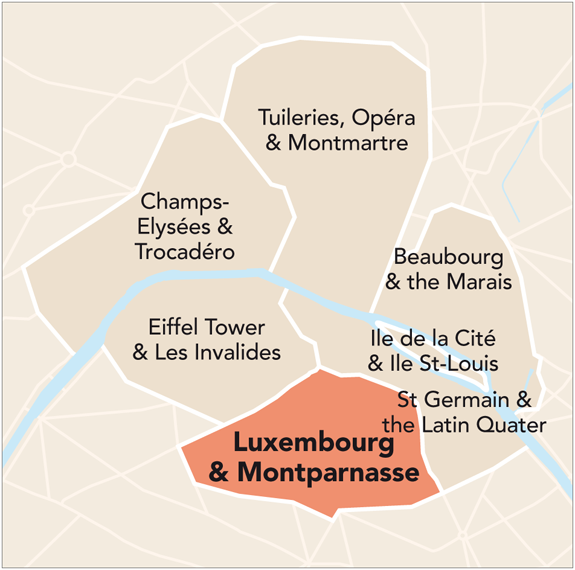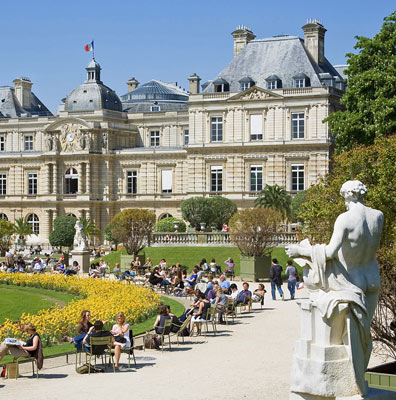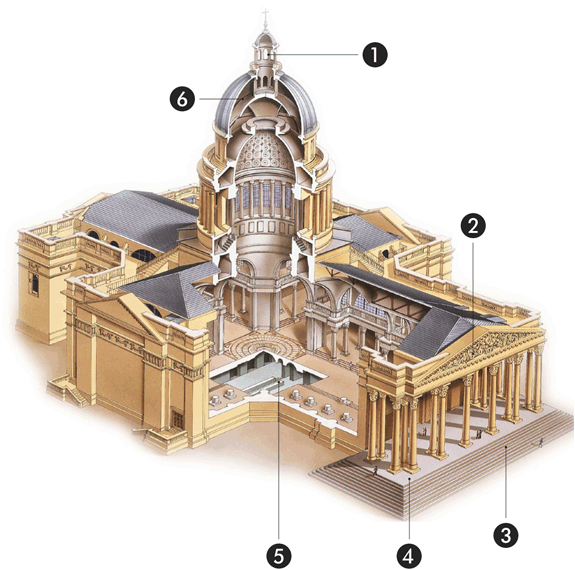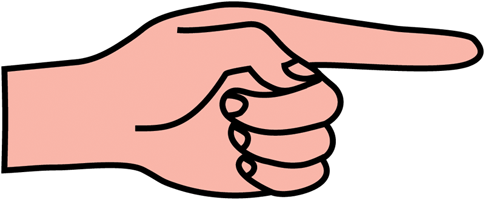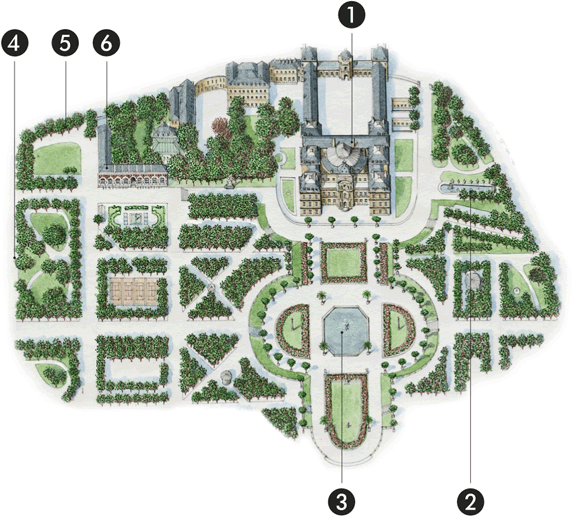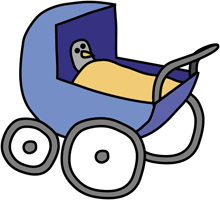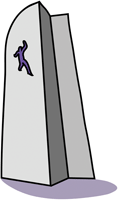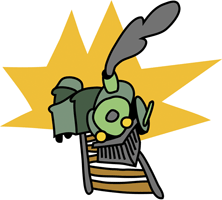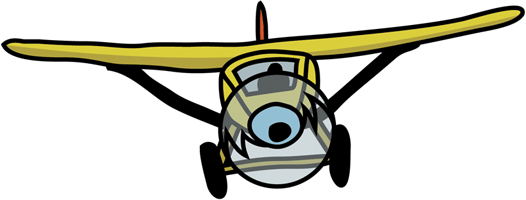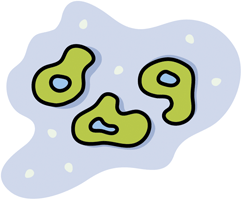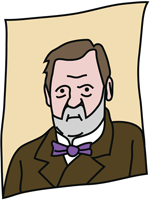The enchanting Jardin du Luxembourg is a Parisian park straight out of a storybook, with its vintage carousel, wooden sailing boats and miniature carriage rides for kids. It is at the heart of an affluent neighbourhood, dominated by the elegant 18th-century dome of the Panthéon and the starkly modern Tour Montparnasse. The area is a joy to explore, with its entertaining mix of old and new, quaint and chic.
The Best of Luxembourg & Montparnasse
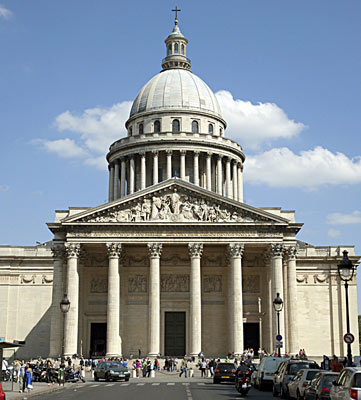
Façade of the Pantheon, with its 22 Corinthian columns
Quiet gardens, cute toyshops and quaint cafés add to the charms of the Luxembourg and Montparnasse quarters. Watch planes take off at Orly Airport from the Tour Montparnasse, or meet some famous dead people at the Cimetière du Montparnasse. Enjoy the views from the top of the Panthéon, then relax in the Jardin du Luxembourg, one of Paris’s most beautiful parks. End the day shopping in the area’s street markets.
Be a little Madeline
Start the day shopping for a dress on
Rue Vavin. Be sure to pick up a copy of author Ludwig Bemelmans’s book
Madeline at the
Oxybul Junior store along the way. Sail wooden boats in the
Jardin du Luxembourg before taking a ride in a princess-style carriage.
Enjoy a hearty lunch at
Bread and Roses on Rue de Fleurus. Afterwards, pay a visit to a great female role model at
Musée Curie. Carry a red balloon up the windy outside staircase to the top of the
Panthéon, let it go and watch it float across the city. Walk back to Rue du Cherche Midi to sample
punitions (bite-sized crunchy biscuits) at
Poilâne.
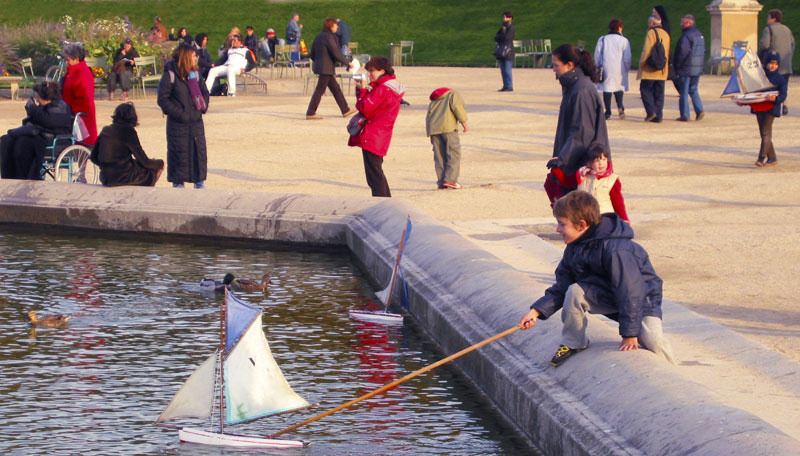
Sailing a wooden boat in the Jardin du Luxembourg
Shoppers’ heaven
Stroll down Rue Vavin buying clothes, toys and books. Pick up bargain jewellery and handbags before choosing something tasty for lunch at the
Marché Edgar Quinet.
Step into Monoprix in the shadow of the Tour Montparnasse for some affordable shopping therapy before walking up Rue de Rennes to buy books, DVDs and computer games in the giant FNAC.
Buy the best bread in town at Poilâne then head to
Le Bon Marché, the city’s oldest department store, and its splendid food hall,
La Grande Epicerie, a perfect place to pick up something appetizing for the family’s dinner.
Impressive art
Learn about the history of France through the giant paintings on display at the Panthéon and get a closer look at the Statue of Liberty in the Jardin du Luxembourg, also home to the atmospheric Fontaine Médicis.
Lunch at
La Coupole where artists whiled away hours in conversation and heated arguments. Relish goodies from Paris’s best bakery,
Eric Kayser, which has many branches in the city.
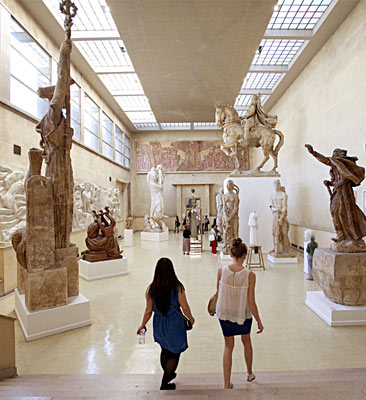
Sculptures at the Musée Antoine Bourdelle
In famous footsteps
Meet some of the most celebrated Frenchmen and one French-Polish lady, the Nobel Prize-winning scientist Marie Curie, in the crypt of the Panthéon, before taking a walk down Rue Pierre et Marie Curie, named after the celebrated scientist Marie Curie and her husband. Count the number of statues of famous people in the Jardin du Luxembourg.
Stop for a drink or a bite to eat at
La Closerie des Lilas in Boulevard du Montparnasse, where the writer Emile Zola lunched with the artist Paul Cezanne while Russian revolutionaries played chess on the terrace. Then walk across to explore the
Cimetière du Montparnasse, which is crammed with the sculptured tombs of prominent singers, actors and writers.
Next, head to Gare Montparnasse, where German forces surrendered to General Leclerc in 1944. Visit the memorial dedicated to him and the Resistance leader Jean Moulin, in the
Jardin Atlantique.
Before stopping for a hot chocolate, pay homage to Louis Pasteur, the man who made milk safe to drink, at the
Musée Pasteur.
< Luxembourg & Montparnasse
Panthéon, Jardin du Luxembourg and Around
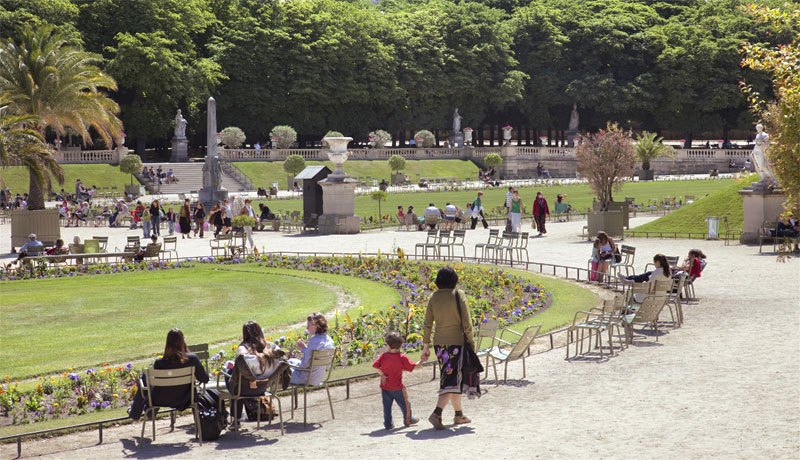
Summer crowds at the sumptuous Jardin du Luxembourg
Choose a nice day to explore this part of town, as the main attraction is the Jardin du Luxembourg, Paris’s best park. Kids will also enjoy the views from the Panthéon’s colonnaded outdoor gallery and from Tour Montparnasse. If approaching the area by metro, aim to avoid the vast interchange Montparnasse Bienvenüe, which involves a lot of tunnel walking. On Sundays and public holidays from March to November, Rue Auguste Comte and Avenue de l’Observatoire, to the south of the Jardin du Luxembourg, are full of pedestrians and Rollerbladers.
1. Panthéon
2. Jardin du Luxembourg
3. Musée Zadkine
4. Tour Montparnasse
5. Musée Antoine Bourdelle
6. Musée de la Poste
7. Musée Jean Moulin
8. Musée Pasteur
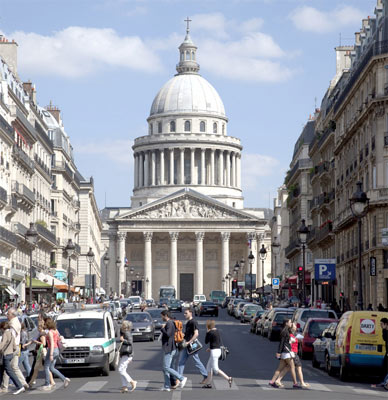
Busy thoroughfare with the Panthéon in the background
1. Panthéon
Pendulums, panoramas and a Pole
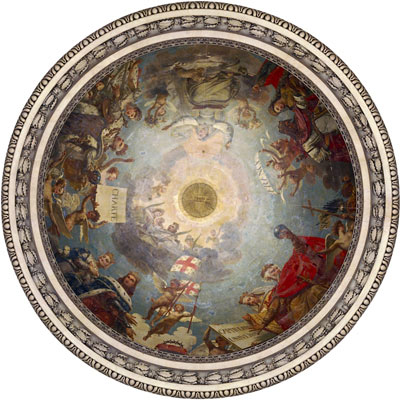
Interior of the dome lantern, Panthéon
The sheer size of the Panthéon is stunning. This Roman-looking temple was commissioned to be built as a church by Louis XV in 1757. However, money for the grandiose project soon ran out, as France teetered on the brink of bankruptcy. By the time it was finished the Revolution was in full swing and churches were out of fashion. It was rededicated as a temple of reason then became the secular resting place of famous people such as Victor Hugo, Emile Zola, Alexandre Dumas and Marie Curie.
Key Features
1. Tall dome The 85-m (278-ft) high dome, partly inspired by St Paul’s in London, has a magnificent ceiling. Climb up for a breathtaking view of Paris.
2. Dome lantern This has a narrow opening that allows only a little light to filter into the church, in keeping with the building’s sombre purpose.
3. Relief sculpture The inscription over the entrance reads Aux Grands Hommes La Patrie Reconnaissante (To the Great Men, the Homeland Acknowledges You).
5. Covered portico The portico with its 22 towering Corinthian columns was modelled on the ancient Panthéon in Rome.
6. Crypt Many French notables rest inside.
• Historical frescoes The murals along the nave’s south wall depict scenes from Paris’s history since the time the city’s patron saint, St Geneviève, prayed to save it from the Huns.
• Statue of Voltaire This stands in front of his tomb in the crypt. There was a rumour that his remains had been stolen but the tomb was opened and they were indeed there.
• Giant pendulum This hangs from the ceiling and marks the spot where the 19th-century physicist Léon Foucault carried out his first experiments to prove the rotation of the Earth on its axis.

Left Historical frescoes Middle Giant pendulum Right Statue of Voltaire
Kids’ Corner
Find out…
-
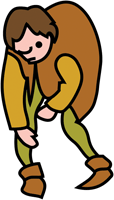
Who is Victor Hugo’s most famous character? Hint: He rings the bells in Notre-Dame.
-
Who is the patron saint of Paris?
-
How many columns are there in the covered portico?
Finger fact
You can see St Geneviève pointing at you in the Church of St-Etienne-du-Mont just next to the Panthéon. Her finger is a priceless relic and is all that remains of her.
Radioactive Marie
Marie Curie was born in Poland in 1867, then part of the Russian Empire. Women were not allowed to go to university there so Marie saved her pennies and went to Paris to study. There she met Pierre Curie, and together they discovered radioactivity.
Radiotherapy has been used to treat millions of people with cancer. The Curies worked without protective clothing as they did not know that radium was dangerously radioactive and could also harm people. Both of them were continually ill and tired. Marie died of the effects of exposure to radioactivity but not before she became the first woman to win not just one Nobel Prize, but two – in physics (1903) and chemistry (1911).
2. Jardin du Luxembourg
Merry-go-round in a children’s paradise
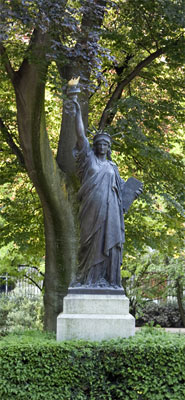
Statue of Liberty in the garden
The Jardin du Luxembourg is Paris’s most gorgeous park and, for younger children, a garden of delights. Especially addictive is trying to spear rings with a wooden sword while riding on the park’s charming merry-go-round, designed by Charles Garnier of Opéra fame. The gardens surround the Palais du Luxembourg, the home of the second chamber of the French parliament, the Senate. The Musée du Luxembourg hosts temporary exhibitions.
Key Features
1. Palais du Luxembourg Marie de Médici built this palace in the style of the Pitti Palace in Florence to remind her of home. The palace also houses an art museum.
2. Fontaine Médicis This 17th-century fountain is built to look like a grotto, a popular feature in Italian Renaissance gardens. Find the statue of a Cyclops here.
3. Octagonal lake Just in front of the palace, this is the best place to watch a gaggle of ducks swimming or children sailing model wooden boats like the storybook character Madeline.
4. Fine statues Over 100 statues were erected in the gardens in the 19th century, among them a mini version of the Statue of Liberty.
6. Théâtre des Marionnettes de Paris Kids will enjoy shows at this theatre even if they do not understand French.
• Fontaine de l‘Observatoire At the garden’s southern tip, this fountain is one of the loveliest in Paris. Four female statues hold up a globe, and there are figures of dolphins, horses and a turtle, too.

Left Fontaine Médicis Middle Palais du Luxembourg Right Fontaine de l’Observatoire
Kids’ Corner
Things to do…
-
Ride in a princess carriage.
-
Dig in the sandpit.
-
Spot the statue of a one-eyed Cyclops near the Fontaine Médicis.
-
Spear more rings than anyone else and win a free ride on the merry-go-round.
-
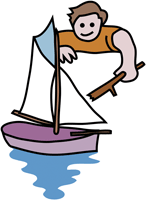
Sail wooden boats and keep your fingers crossed that the ducks will come to your rescue if your boat gets caught by the fountain. They usually help out.
Five continents
There is a statue of four ladies holding up the world in the Fontaine de l’Observatoire. They represent four continents when actually there are five. The one missing is Oceania or Australasia.
Fancy a pigeon pie?
The writer Ernest Hemingway was penniless when he lived near the Jardin du Luxembourg. He used to wheel his one-year-old son, Jack, whom he called Bumby, in a pram around the garden, where plump pigeons would waddle about. Whenever he saw that the policeman had gone to have a glass of wine in a nearby café, he would lure one over with a few grains of corn, snap its neck and pop it under the baby blanket to take home to eat. This happened so often that, by the end of winter, he and his family were thoroughly sick of pigeon.
3. Musée Zadkine
Sculptures and gardens
The former home of the Russian Jewish artist Ossip Zadkine is a pretty but rustic house with a leafy garden complete with a dovecote. Inside is a small museum dedicated to the work of the sculptor, who lived and worked here from 1928 till his death in 1967. The main draw for kids is the pretty garden, which is full of sculptures, including his most famous piece, The Destroyed City, a memorial to the destruction of the Dutch city of Rotterdam in 1940. Born in Belarus, at that time in the Russian Empire, Zadkine went to school with the painter Marc Chagall. Both moved to Paris, where they became part of the strong artistic community that flourished in Montparnasse in the early 20th century.
4. Tour Montparnasse
Up, up, up in the air
At 210 m (688 ft), the Tour Montparnasse is the tallest skyscraper in France. There was such a fuss when it was finished in 1972 that building any more of them in the city centre was banned. As the solitary skyscraper in the city, it provides unparallelled views of the rest of Paris from its rooftop terrace – great for watching the spectacular Bastille Day fireworks each 14 July. Pack binoculars to see the planes taking off at Orly airport from the outdoor viewing deck. In the evening, watch the lights come on and the Eiffel Tower begin to sparkle. It is often overlooked, as most visitors rush to the Eiffel Tower instead. It has the added bonus of rarely being busy, as well as, some might say, the advantage of being the only place in the city from where you can’t see Tour Montparnasse.
Kids’ Corner
Did you know…
Can you guess what the rooftop terrace in Tour Montparnasse is used for?
Shoot to the top
It takes just 38 seconds to get to the top of the Tour Montparnasse in the lift. That is 6 m (19 ft) a second!
Scary stunt
In 1995, the French urban climber, Alain “Spiderman” Robert, scaled the outside of the Tour Montparnasse using only his bare hands and feet and with no safety devices of any kind. It was a daredevil thing to do and he almost fell off. Robert has climbed 85 buildings all over the world, including some of the tallest on earth. He never asks for permission and usually begins his ascent at dawn. Not surprisingly, he has been arrested numerous times. Do not get any ideas and try this one yourself, but check out his stunts at
www.alainrobert.com.
A runaway train
In 1898, a runaway train burst through the thick wall of the façade of the Gare Montparnasse station, sailing out of the platform and nosediving some 10 m (32 feet) onto the ground below. All aboard the train survived. Look for a picture on the Internet.
5. Musée Antoine Bourdelle
Minotaurs and Greek heroes
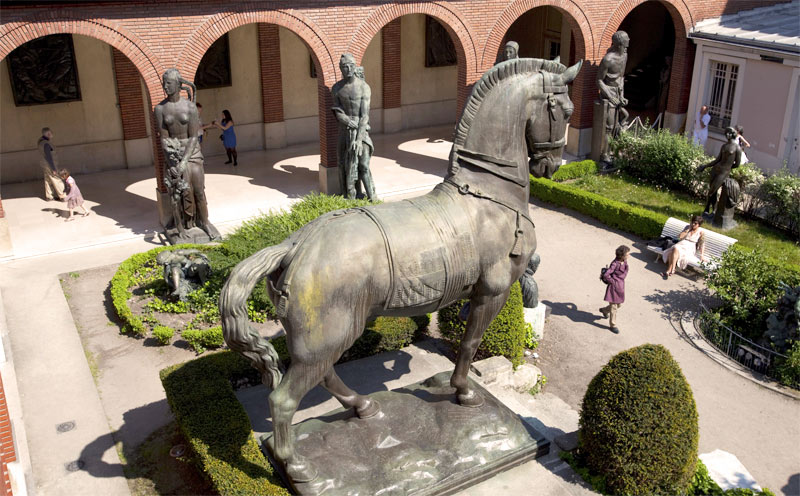
Larger-than-life sculpture of a horse, Musée Antoine Bourdelle
The studio of the sculptor and star pupil of Rodin, Antoine Bourdelle, is a quiet oasis in a little side street, well off the main tourist trail. He worked here from 1884 until his death in 1929, creating some enormous sculptures – their sheer size makes them appealing to children, especially those of a gigantic horse and statues of the Minotaur, Hercules and Apollo. The artist Marc Chagall also briefly worked here. There is a lovely garden full of Bourdelle’s work, which makes it a fun visit with children.
Kids’ Corner
Did you know…
-
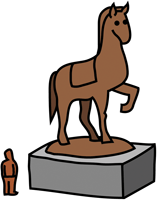
The biggest sculpture of a horse in Paris is in Antoine Bourdelle’s garden.
-
The Minotaur is half man and half bull. Spot the one in Antoine Bourdelle’s garden.
6. Musée de la Poste
Letters and a little prince
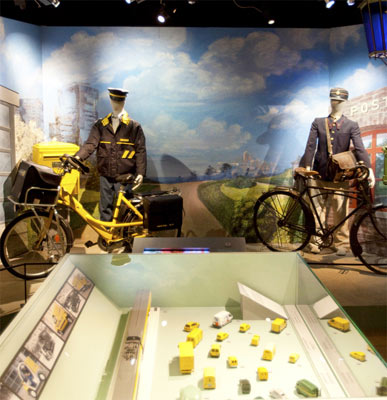
Models of postmen and postal vans, Musée de la Poste
One of Paris’s best offbeat museums, the Musée de la Poste has an engaging collection of old postboxes, telephone cubicles and interactive displays, which make for a fun outing. The museum chronicles the history of the postal and telecommunications service, beginning with a Mesopotamian clay tablet. The author of The Little Prince, Antoine de St-Exupéry, whose childhood classic was inspired by his aviation experiences for the postal service, is featured here among other heroes. The museum also charts the history of France in a unique and accessible way for children. There is a room devoted to the hot-air balloons and carrier pigeons that were used during the siege of Paris in 1871.
Kids’ Corner
The flying prince
The flying postman Antoine de St-Exupéry wrote the magical story
The Little Prince. He flew some of the first air-mail planes, which had few instruments and were very dangerous. Once, he crashed in the middle of the Sahara desert and almost died of thirst. In
The Little Prince, the story begins when a pilot who is marooned in the desert meets a young prince from a tiny asteroid. In 1944, St-Exupéry disappeared over the Mediterranean. The remains of his plane are on display in the
Musée de l’Air et de l’Espace.
7. Musée Jean Moulin
Secret messages, spies and war movies
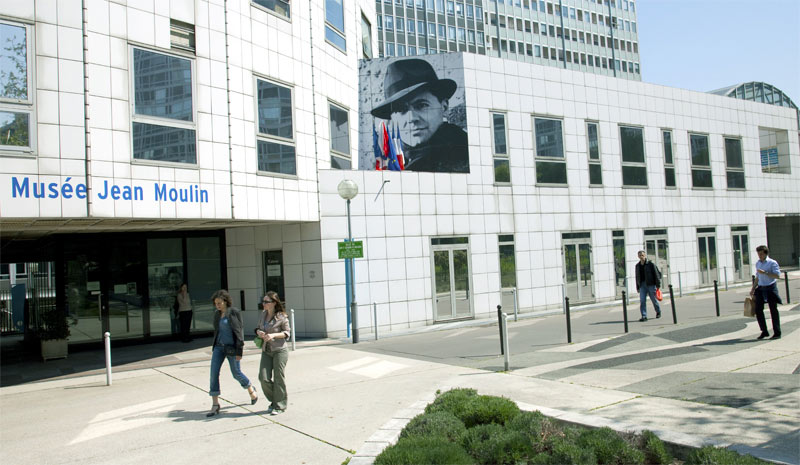
Modernist façade of the Musée Jean Moulin, by the Jardin Atlantique
The tiny Musée Jean Moulin and its accompanying museum, the Mémorial du Maréchal Leclerc de Hauteclocque, focus on life in the French Resistance during World War II and the dramatic days of the liberation of Paris. Both museums document this period through the lives of the Resistance leader Jean Moulin, who is buried in the nearby
Panthéon, and the military leader, Marshal Leclerc. On 25 August 1944, Leclerc set up his command post in Gare Montparnasse station and it was here that the German General Von Choltitz signed the ceasefire.
There is a fascinating collection of coded messages, underground newspapers, photographs and films that bring the Occupation to life. Look out for a radio hidden in a suitcase.
8. Musée Pasteur
Beastly bacteria, mad dogs and rotten wine
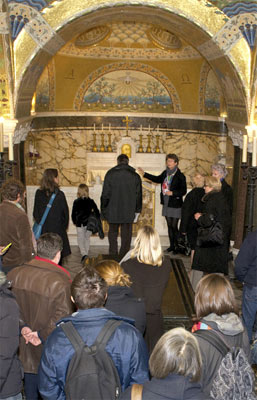
Tomb of Louis Pasteur, in a cellar lined with mosaics celebrating his work
Always remember to raise a toast to the world-renowned scientist Louis Pasteur before drinking a glass of milk. He discovered the process of milk pasteurization, as well as a cure for rabies. The apartment in which he spent the last seven years of his life has been preserved as it was when he died in 1895. It is on the first floor of the scientific centre, Institut Pasteur, which is named after him. Look out for his personal belongings, a vast collection of microscopes and scientific instruments. The famous scientist is buried in the cellar surrounded by mosaics recalling his discoveries.
Kids’ Corner
Bacteria at play
Leave a glass of milk in a hot spot and watch what happens when the bacteria are in action. The milk separates into curds and whey.
Mad dogs and a determined Frenchman
When Pasteur was young, a wolf infected with rabies attacked a little boy in his village. The boy died, but Pasteur never forgot his screams of pain as the villagers tried in vain to save him. Determined to find a cure, he used a course of inoculations to treat a nine-year-old boy who had been bitten by a rabid dog. The boy survived and Pasteur became a hero. Thousands of people came to his funeral in Notre-Dame. There is even a crater on the Moon named after him.
